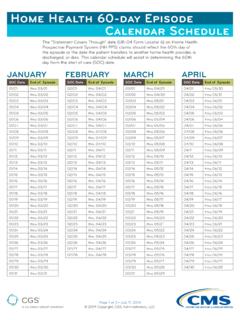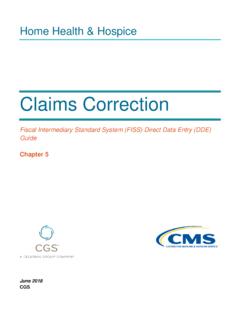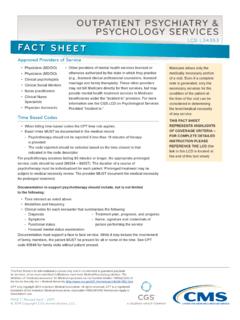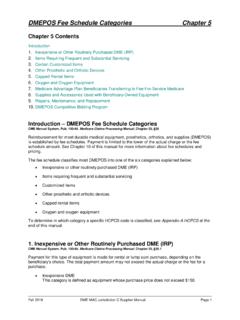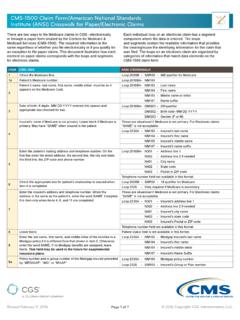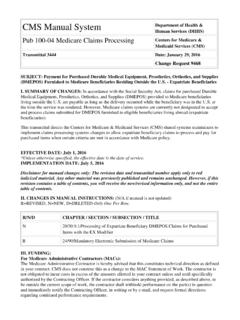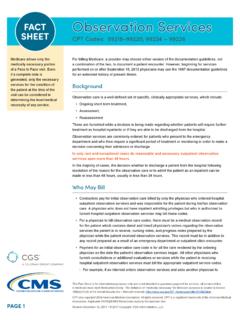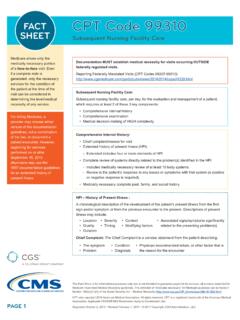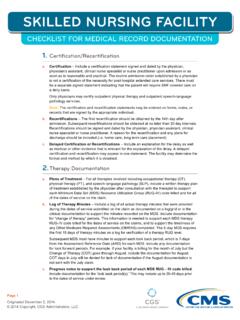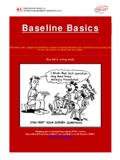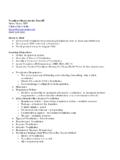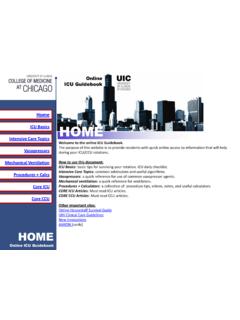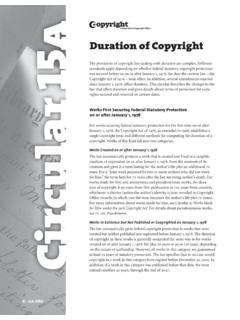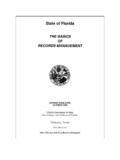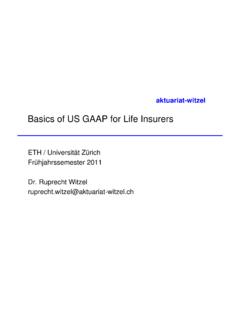Transcription of Basics of Evaluation & Management (E/M) Services
1 Basics of Evaluation and Management (E/M) Services Audio is available via teleconference: Teleconference number: 1-800-592-2259 Participant code: 408029 All lines are muted and there will be silence until the session begins. Questions will be addressed at the end of the session. A certificate of attendance and instructions for obtaining CEU credits from the AAPC will be provided at the end of the session. May 20, 2013 2013 Copyright, CGS Administrators, LLC. 1 Basics of Evaluation and Management (E/M) Services Webinar | Kendra Pickle, RN | May 21, 2013 Disclaimer This presentation was current at the time it was published or uploaded onto the CGS website. Medicare policy changes frequently so links to the source documents have been provided within the document for your reference.
2 This presentation was prepared as a tool to assist providers and is not intended to grant rights or impose obligations. Although every reasonable effort has been made to assure the accuracy of the information within these pages, the ultimate responsibility for the correct submission of claims and response to any remittance advice lies with the provider of Services . The Centers for Medicare & Medicaid Services (CMS) employees, agents, and staff make no representation, warranty, or guarantee that this compilation of Medicare information is error-free and will bear no responsibility or liability for the results or consequences of the use of this guide. This publication is a general summary that explains certain aspects of the Medicare Program, but is not a legal document.
3 The official Medicare Program provisions are contained in the relevant laws, regulations, and rulings. May 20, 2013 2013 Copyright, CGS Administrators, LLC. 3 Objectives Define medical necessity and how it relates to E/M Services . Discuss key differences between the 1995 and 1997 E/M guidelines. Identify and discuss the components of an E/M service focusing on the three key components. Outline general principles of E/M documentation. Discuss the components of selecting the proper E/M code. May 20, 2013 2013 Copyright, CGS Administrators, LLC. 4 Medical Necessity Social Security Act 1862 (a)(1)(A): No payment may be made for items or Services that are not reasonable and necessary for the diagnosis or treatment of illness or injury or to improve the functioning of a malformed body member.
4 CMS guidelines: Medical necessity is the overarching criterion for payment in addition to the individual requirements of a CPT code (CMS Medicare Claims Processing Manual, ch. 12, section ) May 20, 2013 2013 Copyright, CGS Administrators, LLC. 5 E/M Guidelines There are two sets of guidelines that providers may use: 1995 E/M guidelines 1997 E/M guidelines May 20, 2013 2013 Copyright, CGS Administrators, LLC. 6 Components of an E/M service The descriptors for the levels of E/M Services recognize seven components which are used in defining the levels of E/M Services . These components are: History; Examination; Medical Decision Making (MDM); Counseling; Coordination of care; Nature of presenting problem; and Time.
5 May 20, 2013 2013 Copyright, CGS Administrators, LLC. 7 Three Key Components There are three key components when selecting the code that should be billed. These components are: History; Examination; and Medical Decision Making. May 20, 2013 2013 Copyright, CGS Administrators, LLC. 8 The History Provides insight into: The reason for the patient encounter or Chief Complaint (CC); The History of Present Illness (HPI); Provides a review of systems based on the patient s perspective; and Past, Family and Social History (PFSH) May 20, 2013 2013 Copyright, CGS Administrators, LLC. 9 The History Type of History Chief Complaint History of Present Illness Review Of Systems Past, Family and/or Social History Problem Focused Required Brief Expanded Problem Focused Required Brief Problem Pertinent Detailed Required Extended Extended Pertinent Comprehensive Required Extended Complete Complete May 20, 2013 2013 Copyright, CGS Administrators, LLC.
6 10 The Chief Complaint A chief complaint is a concise statement summarizing the symptom, problem, condition, diagnosis or reason for the patient encounter. Usually stated in the patient s own words. For example, Patient complains of back pain. May 20, 2013 2013 Copyright, CGS Administrators, LLC. 11 History of Present Illness (HPI) A chronological description of the development of the patient s chief complaint. HPI elements, with examples, are: Location (example: low back); Quality (example: burning, radiating into left leg); Severity (example: 7 on a scale of 1 10); Duration (example: started one week ago, progressively worsening); Timing (example: constant); Context (example: noticed after lifting furniture while moving); Modifying factors (example: lying down makes pain better, OTC medications relieves some pain); and Associated signs and symptoms (example: numbness in the extremity).
7 May 20, 2013 2013 Copyright, CGS Administrators, LLC. 12 History of Present Illness Brief HPI Complains of low back pain, starting one week ago has tried OTC ibuprofen has had minimal relief. Location low back Duration one week Modifying factors OTC ibuprofen May 20, 2013 2013 Copyright, CGS Administrators, LLC. 13 History of Present Illness Extended HPI Patient complains of low back pain described as a burning pain that radiates into left leg, rates pain a 7 on a scale of 1-10, starting one week ago and progressively worsening, has tried OTC ibuprofen with minimal relief. Location low back Quality burning pain Severity 7 on a scale of 1-10 Duration starting one week ago Modifying factors OTC ibuprofen with minimal relief May 20, 2013 2013 Copyright, CGS Administrators, LLC.
8 14 Review of Systems (ROS) The review of systems is an account of body systems obtained through a series of questions based on the patients perspective. May 20, 2013 2013 Copyright, CGS Administrators, LLC. 15 Review of Systems There are three types of ROS: Problem Pertinent inquires about the system directly related to the problems identified in the HPI. Extended ROS adds a limited number of additional systems. Complete ROS inquires about the system(s) directly related to the problems identified in the HPI plus all additional organ systems. May 20, 2013 2013 Copyright, CGS Administrators, LLC. 16 Past, Family and Social History (PFSH) The PFSH consists of a review of three history areas: Past history: includes recording of prior major illnesses and injuries; operations; hospitalizations; current medications; and allergies.
9 Family history: involves the recording of the health status or cause of death of parents, siblings and children. Social history: contains marital status and/or living arrangements; current employment; and any relevant social history such as the use of drugs, alcohol or tobacco. May 20, 2013 2013 Copyright, CGS Administrators, LLC. 17 Past, Family and Social History There are two types of PFSH: Pertinent review of the history areas directly related to the problem(s) identified in the HPI. Complete review of two or all three of the areas, depending on the category of E/M service. May 20, 2013 2013 Copyright, CGS Administrators, LLC. 18 The History Some tips to remember when documenting the history: Do: Clearly indicate the chief complaint.
10 Describe the HPI in a way that the nature of the presenting problem is clear. Record positive and pertinent negatives. May 20, 2013 2013 Copyright, CGS Administrators, LLC. 19 The History Some tips to remember when documenting the history: Do not: Use the term non-contributory for PFSH. Use negative for the system related to the presenting problem. Count physical observations as the ROS. May 20, 2013 2013 Copyright, CGS Administrators, LLC. 20 The Exam The exam is an assessment of body areas or organ systems performed by the clinician. The exam along with the medical history aids in determining the correct diagnosis and devising a treatment plan. May 20, 2013 2013 Copyright, CGS Administrators, LLC. 21 The Exam The levels of E/M Services are based on four types of examination: Problem Focused A limited examination of the affected body area or organ system; Expanded Problem Focused (EPF) A limited examination of the affected body area or organ system and any other symptomatic or related body area(s) or organ system(s); Detailed An extended examination of the affected body area(s) or organ system(s) and any other symptomatic or related body area(s) or organ system(s); and Comprehensive A general multi-system examination or complete examination of a single organ system (and other symptomatic or related body area(s) or organ system(s) 1997 guidelines).
